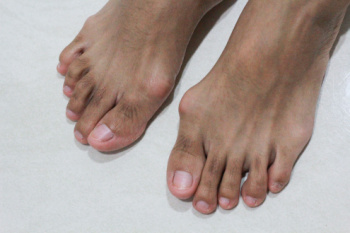
A bunion is more than a bump on the side of the foot. It is a misalignment of the joint at the base of the big toe, which can lead to swelling, redness, and persistent pain. Bunions often develop slowly and may be caused by inherited foot structure, arthritis, or wearing tight shoes that crowd the toes. Early treatment focuses on relieving discomfort and slowing the progression of the deformity. Wearing shoes with a wide toe box and using protective pads can reduce pressure and inflammation. Custom orthotics may help correct foot mechanics and ease strain on the joint. In cases where pain interferes with daily activities, surgical options may be considered to realign the toe and restore function. If you are struggling with bunion pain or notice the deformity is worsening, it is suggested that you see a podiatrist for a proper diagnosis and treatment tailored to your needs.
If you are suffering from bunion pain, contact one of our podiatrists of Pocono Foot & Ankle Consultants. our doctors can provide the care you need to keep you pain-free and on your feet.
What Is a Bunion?
Bunions are painful bony bumps that usually develop on the inside of the foot at the joint of the big toe. As the deformity increases over time, it may become painful to walk and wear shoes. Women are more likely to exacerbate existing bunions since they often wear tight, narrow shoes that shift their toes together. Bunion pain can be relieved by wearing wider shoes with enough room for the toes.
Causes
- Genetics – some people inherit feet that are more prone to bunion development
- Inflammatory Conditions - rheumatoid arthritis and polio may cause bunion development
Symptoms
- Redness and inflammation
- Pain and tenderness
- Callus or corns on the bump
- Restricted motion in the big toe
In order to diagnose your bunion, your podiatrist may ask about your medical history, symptoms, and general health. Your doctor might also order an x-ray to take a closer look at your feet. Nonsurgical treatment options include orthotics, padding, icing, changes in footwear, and medication. If nonsurgical treatments don’t alleviate your bunion pain, surgery may be necessary.
If you have any questions, please feel free to contact our offices located in Stroudsburg, Nazareth, and Easton, PA . We offer the newest diagnostic and treatment technologies for all your foot care needs.
